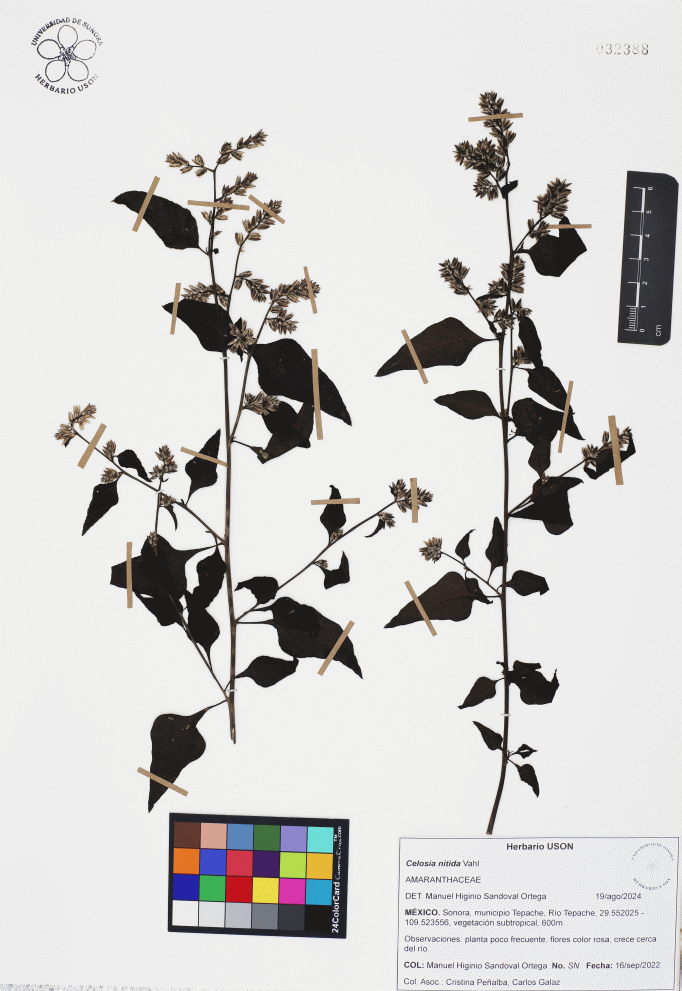Typification of the name Celosia nitida (Amaranthaceae) and first record of this taxon for the state of Sonora, Mexico
DOI:
https://doi.org/10.3986/hacq-2025-0011Keywords:
epitype, flora of Sonora, JamicaAbstract
The lectotype and epitype of the name Celosia nitida are designated and this taxon is reported for the first time for the flora of Sonora, Mexico.
Downloads
References
APG IV (2016). An update of the Angiosperm Phylogeny Group classification for the orders and families of flowering plants: APG IV. Botanical Journal of the Linnean Society 181(1): 1–20.
Das, S. (2016). Amaranthus: A Promising Crop of Future. Springer Nature, Singapore. 208 pp.
E herbarium (2024). Royal Botanic Garden Edinburg, Herbarium Catalogue. Available at: https://data.rbge.org.uk/search/herbarium/ (accessed October 2024).
Engelmann, G. (1986). Instructions for the collection and preservation of botanical specimens. Annals of the Missouri Botanical Garden 73: 504–507.
Hernández-Ledesma, P., Berendsohn, W.G., Borsch, T., Von Mering, S., Akhani, H., Arias, S., Castañeda-Noa, I., Eggli, U., Eriksson, R., Flores-Olvera, H., Fuentes-Bazán, S., Kadereit, G., Klak, C., Korotkova, N., Nyffeler, R., Ocampo, G., Ochoterena, H., Sánchez, B., Schlumpberger, B.O., & Uotila, P. (2015). A taxonomic backbone for the global synthesis of species diversity in the angiosperm order Caryophyllales. Willdenowia 45(3): 281–383.
Hitchcock, A.S. (1929) Nomenclature. Proposals by British Botanists. Wyman & Sons, London, 188 pp.
HUH-Index of Botanists (2013). Harvard University Herbaria & Libraries, Index of Botanist. Available from: https://kiki.huh.harvard.edu/databases/botanist_index.html (consulted September 2024).
Iamonico D. (2023). Nomenclature Survey of the Genus Amaranthus (Amaranthaceae): 12. Questions about Amaranthus caudatus. Plants 12: 1566. https://doi.org/10.3390/plants12071566
JACQ consortium (2024). Virtual Herbaria Website. Available from: https://www.jacq.org/ (consulted October 2024)
JSTOR (2024) JSTOR Global Plants. Available from: https://plants.jstor.org/ (consulted October 2024).
Morrone, J., Escalante, T., & Rodríguez-Tapia, G. (2017). Mexican biogeographic provinces: maps and shapefiles. Zootaxa 4277(2): 277–279. https://doi.org/http://dx.doi.org/10.11646/zootaxa.4277.2.8
Natural History Museum (2024). Herbarium Data Portal. Available from: https://data.nhm.ac.uk/ (consulted October 2024).
P herbarium (2024) Muséum national d’Histoire naturelle, Vascular Plants. Paris. Available from: https://science.mnhn.fr/institution/ mnhn/collection/p/list (consulted October 2024).
POWO (2024). Plants of the World Online. Facilitated by the Royal Botanic Gardens, Kew. Available from: http://www. plantsoftheworldonline.org/
QGIS Development Team. (2017). Quantum GIS Geographic Information System. Quantum GIS Development Team. Open Source Geospatial Foundation Project. Vienna, Austria.
Robertson, K. R. (2003). Celosia (Amaranthaceae). In: Flora of North America Editorial Committee (eds.) Flora of North America North of Mexico (Magnoliophyta: Caryophyllidae, part 1), vol. 4 (pp. 407–409). Oxford University Press, Oxford.
Sandoval-Ortega, M.H., De Loera-Ávila, E.E., Martínez-Calderón, V.M., & Zumaya-Mendoza, S.G. (2023). Plantas silvestres comestibles del estado de Aguascalientes, México, sus formas de consumo y comercialización. Polibotánica 55: 213–230. https://doi.org/10.18387/polibotanica.55.14
Sandoval-Ortega, M.H., & Siqueiros-Delgado, M.E. (2019). Plantas útiles de la familia Amaranthaceae en el estado de Aguascalientes, México. TECNOCIENCIA Chihuahua 13(1): 40–49.
Sloane, H. (1707). A voyage to the islands Madera, Barbados, Nieves, S. Christophers and Jamaica, Vol. 1. B.M., London. 264 pp. https://doi.org/10.5962/bhl.title.642
Standley, P.C. (1917) Amaranthaceae. In: N.L. Britton, W.A. Murrill & J.H. Barnhart (eds.) North American Flora, vol. 21(2) (pp. 95–169). The New York Botanical Garden, New York.
Thiers, B. (2024 [continuously updated]). Index Herbariorum. A global directory of public herbaria and associated staff. New york Botanical Garden’s Virtual Herbarium. Available from http://sweetgum.nybg.org/science/ih
Turland, N.J., Wiersema, J.H., Barrie, F.R., Greuter, W., Hawksworth, D.L., Herendeen, P.S., Knapp, S., Kusber, W.-H., Li, D.-Z., Marhold, K., May, T.W., McNeill, J., Monro, A.M., Prado, J., Price, M.J., & Smith, G.F. (eds.) (2018). International Code of Nomenclature for algae, fungi, and plants (Shenzhen Code). Adopted by the Nineteenth International Botanical Congress, Shenzhen, China, July 2017. Regnum Vegetabile 159: 1–254. https://doi.org/10.12705/Code.2018
Vahl, M. (1791). Symbolae Botanicae, Pars Secunda. Excudebant Nicolaus Möller et Filius, Aulae Regiae Typographi, Hauniae, 108 pp. https://bibdigital.rjb.csic.es/records/item/9751-symbolae-botanicae-pars-secunda
Van Devender, T. R., Felger, R. S., Fishbein M., F. Molina-Freaner, J. J., & Sánchez-Escalante y Reina-Guerrero, A. L. (2010). Biodiversidad de las plantas vasculares. In F. Molina-F. & T. R. Van Devender (eds.), Diversidad Biológica del Estado de Sonora (pp. 229–261). Universidad Nacional Autónoma de México, Hermosillo.
Van Devender, T.R., Reina-Guerrero, A.L., Delgado-Zamora, D., Carnahan, S.D., Anderson, J.L., Hansen, K., Sánchez-Escalante, J.J., & Ferguson, G.M. (2015). Additions to the flora of Sonora, Mexico. II. Phytoneuron 2015-8: 1–6.
Van Devender, T.R., Reina-Guererro, A.L., Flesch, A.D., Jacobs, S., & Wilson, M.F. (2014). Additions to the flora of Sonora, Mexico. Phytoneuron 2014-76: 1–8.
Villaseñor, J.L. (2016). Checklist of the native vascular plants of Mexico. Revista Mexicana de Biodiversidad 87(3): 559–902. https://doi.org/10.1016/j.rmb.2016.06.017
Zumaya-Mendoza, S., & Sánchez-del Pino, I. (2015). Amaranthaceae. In: Medina-Lemos, R. (ed.) Flora del Valle de Tehuacán-Cuicatlán, Fascículo 133 (pp. 1–63). Universidad Nacional Autónoma de México Instituto de Biología, México D.F.

Downloads
Published
How to Cite
Issue
Section
License
Copyright (c) 2024 ZRC-SAZU

This work is licensed under a Creative Commons Attribution-NonCommercial-NoDerivatives 4.0 International License.
Authors guarantee that the work is their own original creation and does not infringe any statutory or common-law copyright or any proprietary right of any third party. In case of claims by third parties, authors commit their self to defend the interests of the publisher, and shall cover any potential costs.
More in: Submission chapter












